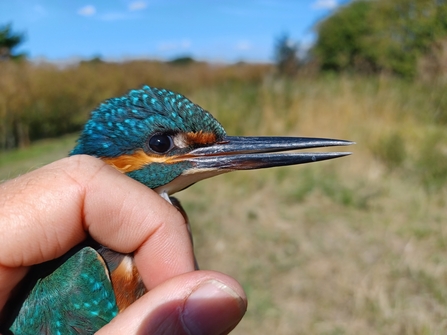With the warm weather upon us again, if only for a brief time, it is worth looking out for dragonflies. Some spring species, such as the variable damselfly, are still around, but we have moved on to summer and the ditches of the Great Fen are now patrolled by the magnificent brown hawker, while along the paths you may encounter the ruddy darter. Southern hawker dragonflies are out and about, as are migrant hawker dragonflies. The willow emerald damselfly is also now on the wing, so watch the tree-lined ditches and other waterbodies, where the males hold their territory.
July sightings
Kingfisher juvenile at Rymes Reedbed, 28 July 2024, by Henry Stanier
Butterflies and moths are finally increasing in number, after a bad start, but it is now that part of the year when wildlife is on the move, so watch out for migrant species. Migratory moths, such as the day-flying silver Y and hummingbird hawk-moth could be out in the Great Fen meadows, as well as your back garden.
Birds are also on the move, forming flocks again in search of food and in some cases, preparing to leave the country. One of two juvenile cuckoos are still around, while other species will soon be passing through, heading south. Plenty of young birds are about, including lapwings, kingfishers, reed buntings and reed and sedge warblers.
In the meantime, hobbies are hunting dragonflies, often late into the evening, and some of our local kestrels also have a go at sampling this food source. Now that hay is being cut, check for birds of prey perched on the bales; buzzards, kestrels and sparrowhawks for example.

Kingfisher juvenile at Rymes Reedbed, 28 July 2024, by Henry Stanier
It has been a good year for meadowsweet and hemp-agrimony, both good nectar sources, so a closer inspection of these wetland plants (watch out for bees and wasps), may also reveal day-flying moths and a longhorn beetle or two. If you are lucky, you may spot our biggest longhorn beetle, the musk beetle!
Talking about big beetles, it was great to be able to follow up the blog about the great silver water beetle discovery with Anita Rani during her visit to the Fens with the Countryfile team. Following the blog, I learned that Edward Bayley had encountered this beast of a beetle on Mersea Island (Essex) and so I was able to confirm his discovery; it's good to share. As it warms up, hopefully the moths will continue to respond and we may even record some big water beetles in the moth traps in the coming months!
Henry Stanier (Great Fen Monitoring & Research Officer)

Great silver water beetle on Mersea Island by Edward Bayley, April 2024



